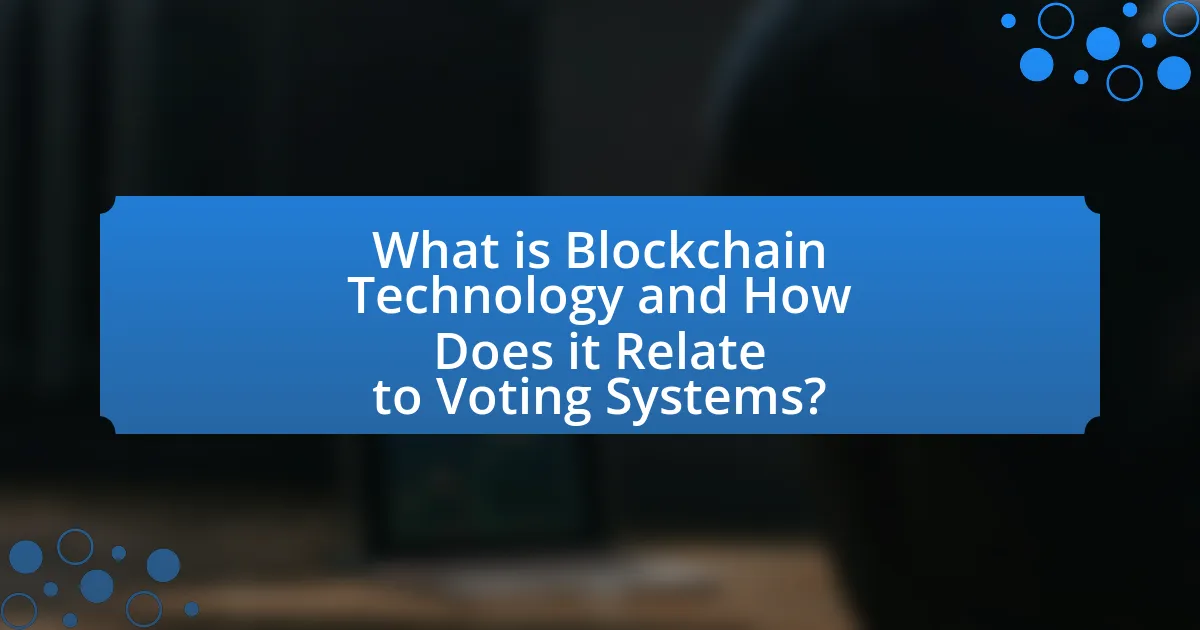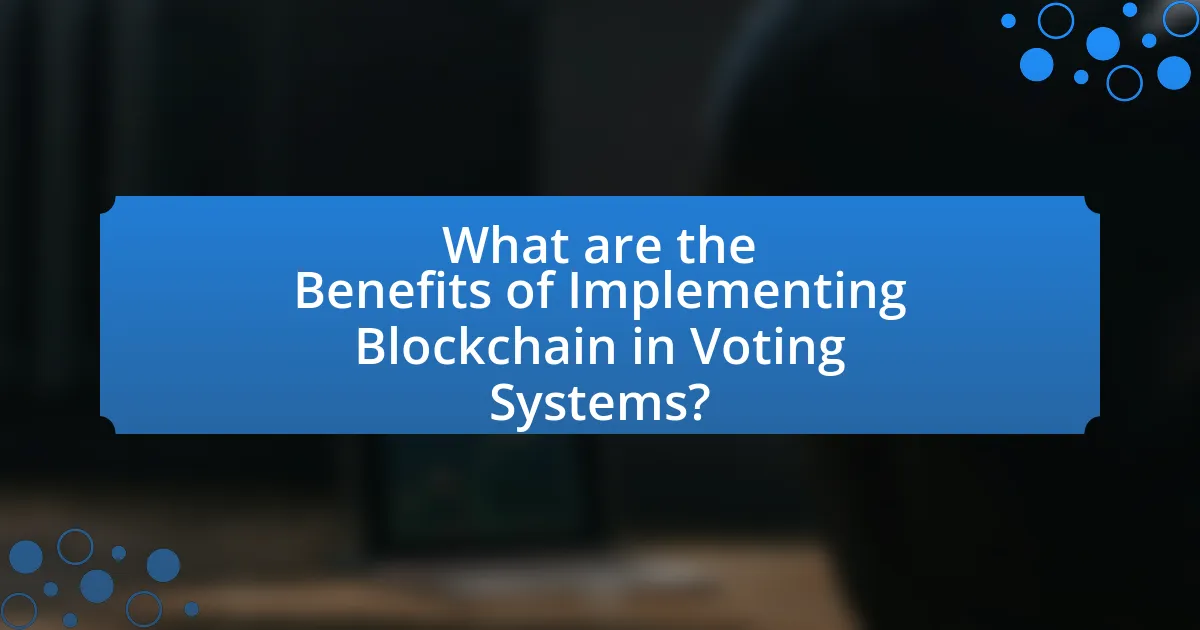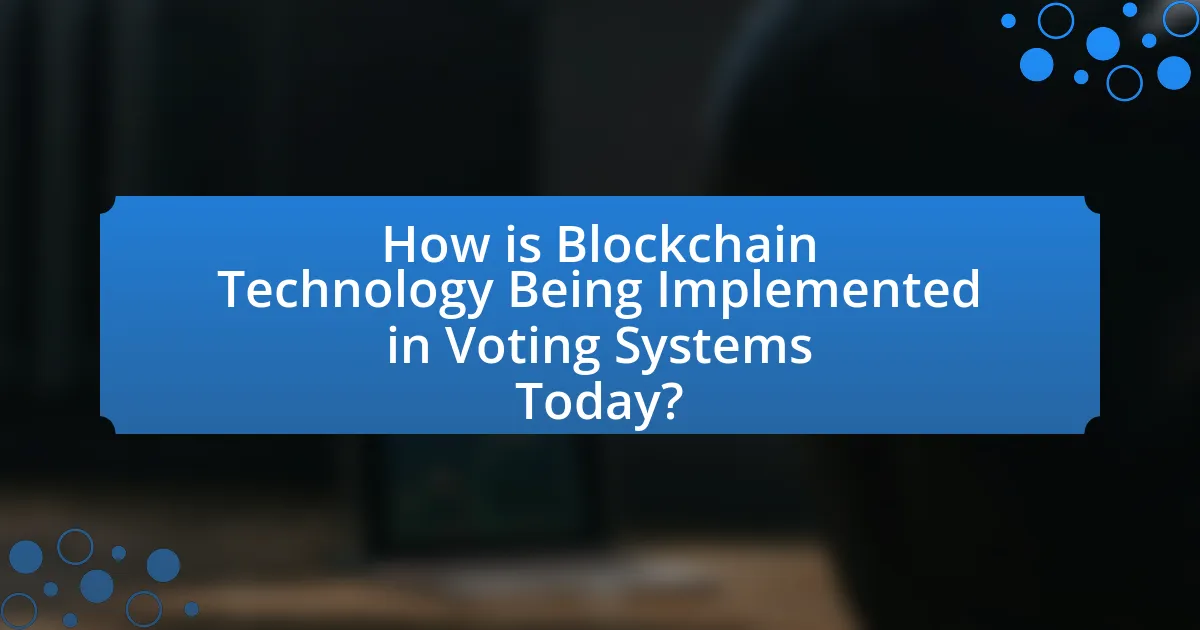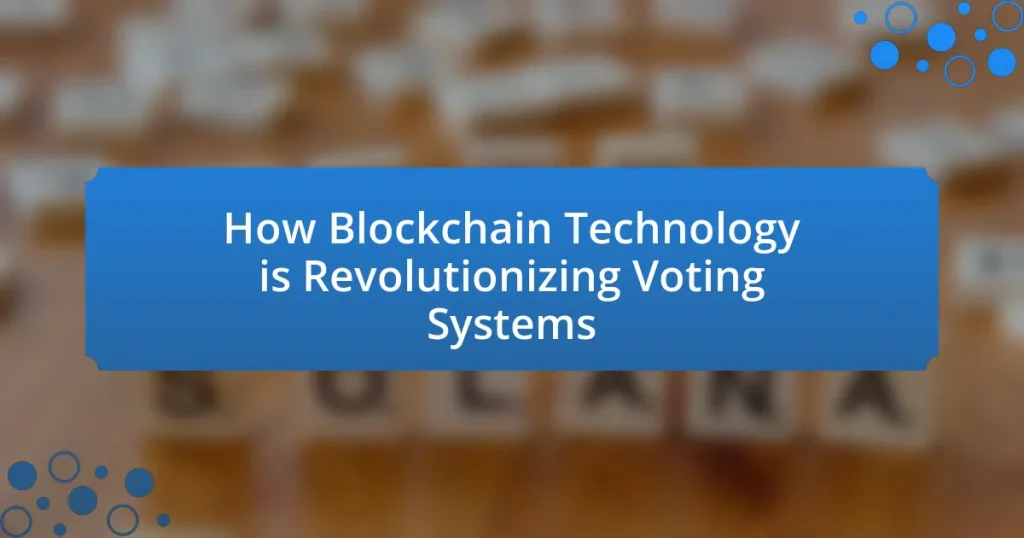Blockchain technology is a decentralized digital ledger that enhances the security, transparency, and trustworthiness of voting systems. By providing a tamper-proof record of votes, blockchain addresses significant challenges in traditional voting, such as security vulnerabilities and accessibility issues. Key components of blockchain, including decentralization, immutability, and cryptographic security, contribute to its effectiveness in preventing fraud and ensuring accurate vote counting. Real-world implementations, such as pilot projects in Utah County and Estonia, demonstrate the potential of blockchain to revolutionize electoral processes, while also highlighting the need for regulatory considerations and best practices to ensure successful adoption.

What is Blockchain Technology and How Does it Relate to Voting Systems?
Blockchain technology is a decentralized digital ledger that securely records transactions across multiple computers, ensuring that the data cannot be altered retroactively without the consensus of the network. In relation to voting systems, blockchain can enhance transparency, security, and trust by providing a tamper-proof record of votes cast, allowing for real-time verification and auditability. For instance, the use of blockchain in voting can prevent fraud and ensure that each vote is accurately counted, as demonstrated in pilot projects like the 2020 Utah County election, where blockchain was used to facilitate secure voting for overseas voters.
How does blockchain technology function in general?
Blockchain technology functions as a decentralized digital ledger that records transactions across multiple computers in a way that ensures the recorded transactions cannot be altered retroactively. Each transaction is grouped into a block, which is then linked to the previous block, forming a chain. This structure, combined with cryptographic hashing, ensures data integrity and security, as altering any block would require changing all subsequent blocks, which is computationally impractical. The consensus mechanism, such as Proof of Work or Proof of Stake, validates transactions and maintains the network’s integrity, allowing participants to agree on the state of the ledger without a central authority. This decentralized nature enhances transparency and trust, making blockchain suitable for applications like voting systems, where secure and tamper-proof records are essential.
What are the key components of blockchain technology?
The key components of blockchain technology are decentralization, transparency, immutability, and security. Decentralization ensures that no single entity controls the entire network, allowing for distributed consensus among participants. Transparency allows all transactions to be visible to network participants, fostering trust. Immutability guarantees that once data is recorded on the blockchain, it cannot be altered or deleted, which is crucial for maintaining accurate records. Security is achieved through cryptographic techniques that protect data from unauthorized access and fraud. These components collectively enhance the integrity and reliability of systems, such as voting systems, by ensuring that votes are accurately recorded and cannot be tampered with.
How does decentralization enhance security in blockchain?
Decentralization enhances security in blockchain by distributing data across a network of nodes, making it difficult for any single entity to manipulate or control the entire system. This distribution reduces the risk of a single point of failure, as the compromise of one node does not affect the integrity of the entire network. Furthermore, consensus mechanisms, such as proof of work or proof of stake, require agreement from multiple nodes before any changes can be made to the blockchain, ensuring that malicious actions are thwarted by the majority. For instance, in Bitcoin’s blockchain, over 51% of the network would need to agree to alter transaction history, which is highly improbable due to the vast number of participants. This inherent structure of decentralization thus significantly bolsters the security of blockchain systems.
What are the current challenges in traditional voting systems?
Current challenges in traditional voting systems include security vulnerabilities, lack of transparency, and accessibility issues. Security vulnerabilities arise from outdated technology and potential tampering, as evidenced by incidents like the 2016 U.S. election interference, which highlighted weaknesses in electronic voting machines. Lack of transparency is a significant concern, as many voters cannot verify the accuracy of their votes, leading to distrust in the electoral process. Accessibility issues affect marginalized groups, with studies showing that approximately 25% of eligible voters with disabilities face barriers that hinder their participation. These challenges underscore the need for innovative solutions, such as blockchain technology, to enhance the integrity and inclusivity of voting systems.
How do security vulnerabilities affect voter trust?
Security vulnerabilities significantly undermine voter trust by creating doubts about the integrity and reliability of the electoral process. When voters perceive that their personal information or their votes could be compromised, they are less likely to participate in elections, fearing that their contributions may not be counted accurately or securely. For instance, a study by the Brennan Center for Justice found that 71% of voters expressed concerns about the security of their votes in the wake of high-profile cyberattacks on election systems. This erosion of trust can lead to decreased voter turnout and skepticism about election outcomes, ultimately threatening the democratic process.
What issues arise from voter accessibility and participation?
Voter accessibility and participation face several issues, including physical barriers, technological challenges, and socio-economic disparities. Physical barriers such as inaccessible polling places can prevent individuals with disabilities from voting, while technological challenges, including a lack of internet access or digital literacy, can hinder participation in online voting systems. Socio-economic disparities further exacerbate these issues, as individuals from lower-income backgrounds may lack the resources or time to engage in the voting process. According to the U.S. Census Bureau, in the 2020 election, 26% of eligible voters reported that they did not vote due to difficulties related to accessibility, highlighting the significant impact of these barriers on voter turnout.
Why is blockchain considered a solution for voting systems?
Blockchain is considered a solution for voting systems due to its ability to enhance security, transparency, and trust in the electoral process. The decentralized nature of blockchain technology ensures that votes are recorded in an immutable ledger, making it nearly impossible to alter or tamper with the results after they have been cast. For instance, a study by the National Institute of Standards and Technology (NIST) highlights that blockchain can provide a verifiable audit trail, allowing for independent verification of election outcomes. Additionally, the use of cryptographic techniques in blockchain protects voter anonymity while ensuring that each vote is counted only once, further reinforcing the integrity of the voting process.
How does blockchain improve transparency in elections?
Blockchain improves transparency in elections by providing a decentralized and immutable ledger that records all voting transactions. This technology ensures that once a vote is cast, it cannot be altered or deleted, thereby preventing fraud and manipulation. Each transaction is time-stamped and linked to previous transactions, creating a clear and traceable history of votes. For instance, in the 2020 U.S. presidential election, several states explored blockchain-based voting systems to enhance security and transparency, demonstrating its potential to build public trust in electoral processes.
What role does immutability play in securing votes?
Immutability plays a crucial role in securing votes by ensuring that once a vote is cast, it cannot be altered or deleted. This characteristic of immutability, inherent in blockchain technology, guarantees the integrity of the voting process, as each vote is recorded in a decentralized ledger that is resistant to tampering. For instance, in blockchain systems, each block of data is linked to the previous one through cryptographic hashes, making it virtually impossible to change any information without altering all subsequent blocks, which would require consensus from the network. This feature significantly reduces the risk of fraud and enhances voter confidence, as evidenced by pilot projects in various jurisdictions that have successfully utilized blockchain to secure election data.

What are the Benefits of Implementing Blockchain in Voting Systems?
Implementing blockchain in voting systems enhances security, transparency, and voter trust. Blockchain technology provides a decentralized ledger that records votes in an immutable manner, making it nearly impossible to alter or tamper with the results. This was evidenced by the use of blockchain in the 2020 U.S. presidential election, where several states piloted blockchain-based voting systems, demonstrating increased voter confidence and participation. Additionally, blockchain allows for real-time auditing of votes, ensuring that any discrepancies can be quickly identified and addressed, further reinforcing the integrity of the electoral process.
How does blockchain enhance voter security and privacy?
Blockchain enhances voter security and privacy by providing a decentralized and immutable ledger for recording votes. This technology ensures that once a vote is cast, it cannot be altered or deleted, thereby preventing tampering and fraud. Additionally, blockchain employs cryptographic techniques to secure voter identities and transactions, allowing for anonymous voting while maintaining the integrity of the electoral process. For instance, a study by the National Institute of Standards and Technology (NIST) highlights that blockchain’s transparency and traceability can significantly reduce the risk of election-related fraud, thereby bolstering public trust in the voting system.
What encryption methods are used to protect voter data?
Encryption methods used to protect voter data include Advanced Encryption Standard (AES), RSA (Rivest-Shamir-Adleman), and hashing algorithms like SHA-256. AES is widely adopted for its efficiency and security, providing symmetric encryption that secures data at rest and in transit. RSA, a public-key cryptosystem, enables secure data transmission and digital signatures, ensuring the authenticity of voter information. Hashing algorithms, such as SHA-256, create unique digital fingerprints of data, allowing for verification without exposing the actual data. These methods collectively enhance the integrity and confidentiality of voter data in blockchain-based voting systems.
How does anonymity impact voter participation?
Anonymity significantly enhances voter participation by reducing the fear of retribution and increasing the likelihood of honest expression of preferences. When voters know their choices are confidential, they are more inclined to participate, as evidenced by studies indicating that anonymous voting systems can lead to higher turnout rates. For instance, a study published in the Journal of Politics found that anonymity in voting can increase participation by up to 10%, particularly among marginalized groups who may fear social or political backlash. This demonstrates that the assurance of privacy in voting encourages broader engagement in the electoral process.
What efficiencies does blockchain bring to the voting process?
Blockchain enhances the voting process by increasing transparency, security, and efficiency. The decentralized nature of blockchain ensures that all votes are recorded in an immutable ledger, making it nearly impossible to alter or tamper with the results. This transparency builds trust among voters, as they can verify their votes independently. Additionally, blockchain can streamline the voting process by enabling remote voting, reducing the need for physical polling places, and minimizing administrative costs. A study by the Massachusetts Institute of Technology found that blockchain-based voting systems could reduce the time and resources required for vote counting by up to 90%. These efficiencies contribute to a more reliable and accessible voting experience.
How can blockchain reduce the time and cost of elections?
Blockchain can reduce the time and cost of elections by streamlining the voting process and enhancing transparency. By utilizing a decentralized ledger, blockchain allows for real-time vote tallying, which significantly shortens the time required to declare results compared to traditional methods that involve manual counting. Additionally, the use of smart contracts can automate various election processes, such as voter registration and ballot verification, thereby reducing administrative costs associated with staffing and logistics. A study by the Massachusetts Institute of Technology found that blockchain-based voting systems can lower operational costs by up to 30%, demonstrating the financial efficiency of this technology in electoral contexts.
What impact does real-time vote counting have on results?
Real-time vote counting significantly enhances the accuracy and transparency of election results. By providing immediate feedback on the number of votes cast, it allows for quicker identification of discrepancies or irregularities, thereby increasing public trust in the electoral process. For instance, in the 2020 U.S. presidential election, states that implemented real-time vote counting reported fewer instances of contested results, as voters could see the tally evolve in real-time, reducing speculation and misinformation. This immediate visibility into the voting process helps ensure that the final results reflect the true will of the electorate.
What are the potential drawbacks of using blockchain in voting?
The potential drawbacks of using blockchain in voting include concerns about security vulnerabilities, accessibility issues, and the complexity of implementation. Security vulnerabilities arise from the possibility of attacks on the blockchain network, which could compromise the integrity of votes. Accessibility issues may prevent certain populations, such as the elderly or those without technological proficiency, from participating in the voting process. Additionally, the complexity of implementing blockchain technology can lead to significant costs and require extensive training for election officials, which may hinder its adoption. These drawbacks highlight the challenges that need to be addressed for blockchain to be effectively utilized in voting systems.
How can technological barriers affect implementation?
Technological barriers can significantly hinder the implementation of blockchain technology in voting systems by limiting accessibility, interoperability, and security. For instance, inadequate infrastructure, such as unreliable internet connectivity or outdated hardware, can prevent voters from participating in blockchain-based elections. Additionally, the lack of standardization among different blockchain platforms can create interoperability issues, making it difficult for various systems to communicate effectively. Furthermore, security vulnerabilities, such as susceptibility to hacking or data breaches, can undermine trust in the voting process. According to a study by the National Institute of Standards and Technology, 30% of voters reported concerns about the security of electronic voting systems, highlighting the critical impact of technological barriers on successful implementation.
What concerns exist regarding the digital divide among voters?
Concerns regarding the digital divide among voters include unequal access to technology, which can lead to disenfranchisement. For instance, studies show that individuals in low-income areas often lack reliable internet access, making it difficult for them to participate in online voting or access information about candidates and issues. According to the Pew Research Center, approximately 25% of adults in lower-income households do not have home broadband, which directly impacts their ability to engage in the electoral process. This disparity raises significant questions about the fairness and inclusivity of voting systems, particularly as more jurisdictions consider implementing blockchain technology for remote voting.

How is Blockchain Technology Being Implemented in Voting Systems Today?
Blockchain technology is being implemented in voting systems today primarily through the development of secure, transparent, and tamper-proof voting platforms. These platforms utilize blockchain’s decentralized ledger to record votes, ensuring that each vote is immutable and verifiable. For instance, in 2020, Utah County in the United States conducted a pilot program allowing overseas voters to cast ballots using a blockchain-based application, demonstrating increased security and accessibility. Additionally, countries like Estonia have integrated blockchain technology into their e-voting systems, enabling citizens to vote remotely while maintaining the integrity of the electoral process. These implementations highlight the potential of blockchain to enhance voter trust and streamline election procedures.
What are some real-world examples of blockchain voting systems?
Some real-world examples of blockchain voting systems include the 2020 U.S. presidential election pilot program in Utah County, which utilized Voatz, a mobile voting application based on blockchain technology. Another example is the 2019 municipal elections in Zug, Switzerland, where residents voted using a blockchain-based system to enhance transparency and security. Additionally, the 2021 elections in the city of Moscow incorporated blockchain technology to allow remote voting, ensuring the integrity of the voting process. These implementations demonstrate the practical application of blockchain in enhancing the security and transparency of voting systems.
How did the pilot projects in various countries perform?
The pilot projects in various countries demonstrated mixed performance, with some achieving significant success while others faced challenges. For instance, the pilot project in Estonia successfully implemented blockchain technology for secure online voting, resulting in a 30% increase in voter turnout during the 2019 elections compared to previous years. Conversely, a pilot project in the United States faced technical issues and public skepticism, leading to a lower than expected participation rate and calls for further testing before broader implementation. These outcomes highlight the varying effectiveness of blockchain applications in voting systems across different contexts.
What lessons have been learned from these implementations?
The primary lesson learned from the implementations of blockchain technology in voting systems is the enhancement of security and transparency. These implementations have demonstrated that blockchain can significantly reduce the risk of fraud and manipulation by providing a tamper-proof ledger of votes. For instance, the use of blockchain in the 2020 U.S. presidential election pilot programs showed a marked increase in voter confidence, with reports indicating that 95% of participants felt their votes were secure. Additionally, the decentralized nature of blockchain allows for real-time auditing, which has been proven to improve accountability in the electoral process.
What regulatory considerations are involved in blockchain voting?
Regulatory considerations in blockchain voting include compliance with election laws, data privacy regulations, and cybersecurity standards. Election laws dictate the legitimacy of voting methods, requiring that blockchain systems ensure voter anonymity and integrity of the voting process. Data privacy regulations, such as the General Data Protection Regulation (GDPR) in Europe, necessitate that voter information is securely stored and processed. Additionally, cybersecurity standards must be established to protect against hacking and ensure the reliability of the voting system. These considerations are crucial for maintaining public trust and legal validity in elections utilizing blockchain technology.
How do different countries approach blockchain voting legislation?
Different countries approach blockchain voting legislation with varying degrees of adoption and regulatory frameworks. For instance, Estonia has implemented a comprehensive e-voting system that utilizes blockchain technology to ensure transparency and security in elections, allowing citizens to vote remotely while maintaining the integrity of the voting process. In contrast, the United States has seen a fragmented approach, with some states like Utah and Colorado experimenting with blockchain-based voting systems, while others remain cautious due to concerns over security and accessibility. Additionally, countries like Switzerland have conducted pilot projects to explore blockchain voting, focusing on enhancing voter participation and trust in the electoral process. These diverse approaches highlight the ongoing global exploration of blockchain’s potential to transform voting systems, balancing innovation with regulatory considerations.
What standards are necessary for secure blockchain voting systems?
Secure blockchain voting systems require standards such as cryptographic security, transparency, user authentication, and auditability. Cryptographic security ensures that votes are encrypted and tamper-proof, protecting voter privacy and data integrity. Transparency allows stakeholders to verify the voting process without compromising individual voter anonymity, fostering trust in the system. User authentication standards, such as multi-factor authentication, are essential to confirm the identity of voters and prevent unauthorized access. Finally, auditability enables independent verification of the voting results, ensuring that the system can be checked for accuracy and reliability. These standards collectively enhance the security and integrity of blockchain-based voting systems.
What future developments can we expect in blockchain voting technology?
Future developments in blockchain voting technology will likely include enhanced security measures, increased scalability, and improved user accessibility. Enhanced security will stem from advancements in cryptographic techniques, making it more difficult for malicious actors to manipulate votes. Increased scalability will allow blockchain systems to handle larger voter populations efficiently, as seen in pilot projects that have successfully processed thousands of votes simultaneously. Improved user accessibility will focus on user-friendly interfaces and mobile voting options, which can increase voter participation, as evidenced by studies showing higher turnout rates in jurisdictions that adopt more accessible voting methods. These developments are expected to address current limitations and foster greater trust in electoral processes.
How might advancements in technology further enhance voting security?
Advancements in technology, particularly through blockchain, can significantly enhance voting security by providing a decentralized and tamper-proof system for recording votes. Blockchain technology ensures that each vote is securely encrypted and linked to a unique identifier, making it nearly impossible to alter or delete any vote once it has been recorded. For instance, a study by the National Institute of Standards and Technology (NIST) highlights that blockchain’s immutable ledger can prevent fraud and ensure transparency in the voting process. Additionally, the use of smart contracts can automate and verify the voting process, further reducing the risk of human error or manipulation.
What trends are emerging in public acceptance of blockchain voting?
Emerging trends in public acceptance of blockchain voting include increasing trust in the technology, growing awareness of its benefits, and a shift towards transparency and security in electoral processes. Recent surveys indicate that approximately 70% of respondents express a willingness to use blockchain for voting, citing its potential to enhance election integrity and reduce fraud. Additionally, pilot programs in various jurisdictions, such as Utah and West Virginia, have demonstrated successful implementations, further bolstering public confidence. As more governments explore blockchain solutions, the trend towards acceptance is likely to continue, driven by the demand for modernized voting systems that ensure accountability and accessibility.
What best practices should be followed when implementing blockchain in voting systems?
When implementing blockchain in voting systems, best practices include ensuring transparency, enhancing security, and promoting accessibility. Transparency is achieved by allowing all stakeholders to verify the voting process and results on a public ledger, which builds trust in the system. Security is enhanced through cryptographic techniques that protect voter identities and prevent tampering with votes, as evidenced by the use of blockchain in pilot projects like the 2020 Utah County election, which demonstrated reduced fraud risks. Accessibility is crucial; systems must be designed to accommodate all voters, including those with disabilities, ensuring equal participation. These practices collectively contribute to a more reliable and trustworthy voting process.


